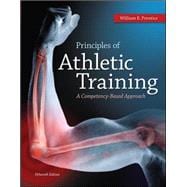
Note: Supplemental materials are not guaranteed with Rental or Used book purchases.
Purchase Benefits
Looking to rent a book? Rent Principles of Athletic Training: A Competency-Based Approach [ISBN: 9780078022647] for the semester, quarter, and short term or search our site for other textbooks by Prentice, William. Renting a textbook can save you up to 90% from the cost of buying.